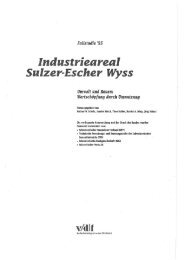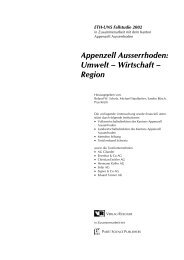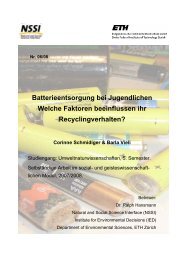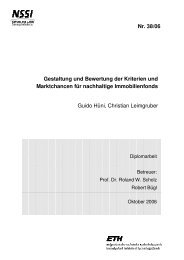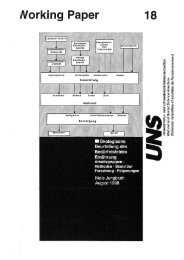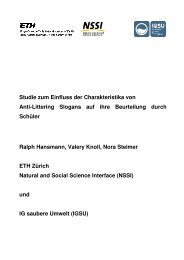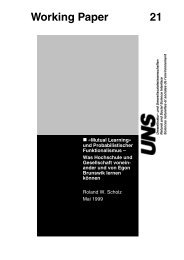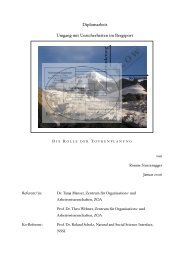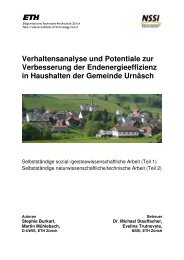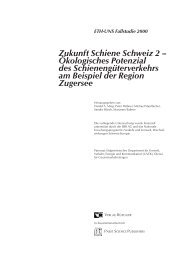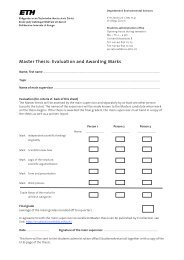The Paradigm of Human-Environment Systems - Natural and Social ...
The Paradigm of Human-Environment Systems - Natural and Social ...
The Paradigm of Human-Environment Systems - Natural and Social ...
Create successful ePaper yourself
Turn your PDF publications into a flip-book with our unique Google optimized e-Paper software.
<strong>The</strong> <strong>Paradigm</strong> <strong>of</strong> <strong>Human</strong>-<strong>Environment</strong> <strong>Systems</strong><br />
<strong>The</strong> reciprocity between human <strong>and</strong> environment systems, or the H ↔ E impact chains,<br />
can be approached from the environmental as well as from the human perspective. <strong>The</strong> former<br />
looks at optimizing environmental quality by integrating human models into ecosystem analysis<br />
(Naveh & Lieberman, 1994). <strong>The</strong> latter investigates the impact <strong>of</strong> regulatory mechanisms on<br />
the state <strong>of</strong> the environment, taking an anthropogenic perspective (Hammond, et al., 1995). For<br />
example, “human ecologists study the influence that our surroundings exert on the physical<br />
<strong>and</strong> social growth <strong>of</strong> humans from conceptus to death” (retrieved from the net, 13.02.03, Clarke,<br />
2003; Tengström, 1985).<br />
A special focus is given to H∩E within the H ↔ E relationship. <strong>The</strong> GAIA approach<br />
(Lovelock, 1979) “views the earth as a single organism, in which the individual elements coexist<br />
in a symbiotic relationship. Internal homeostatic control mechanisms, involving positive <strong>and</strong><br />
negative feedbacks, maintain an appropriate level <strong>of</strong> stability.” (Kemp, 1998, p.160) GAIA is an<br />
example <strong>of</strong> an integrative, qualitative approach for studying HES. Integrative modeling starts<br />
from coupled systems <strong>and</strong> provides a quantitative analysis (Bossel, 1998; Carpenter et al., 1999;<br />
Walker et al., 2002). Many <strong>of</strong> these modeling approaches are shaped by general system theory.<br />
Impact<br />
chain<br />
Table 1: Examples for research fields on HES according to the focused impact chain(s).<br />
Primary object <strong>of</strong> research<br />
<strong>Environment</strong> system <strong>Human</strong> system<br />
E → H<br />
— Toxicology, public health, environmental<br />
psychology, human geography,<br />
etc.<br />
H → E<br />
E ↔ H<br />
<strong>Environment</strong>al natural sciences (e.g., environmental<br />
chemistry); conservation biology, soil protection,<br />
<strong>Environment</strong>al Impact Assessment<br />
Integrative Ecosystems, L<strong>and</strong>scape ecology,<br />
Biocybernetics, etc.<br />
H∩E<br />
Agriculture, forest, food, <strong>and</strong> resource<br />
economics or management<br />
<strong>Human</strong> ecology, Pressure state models,<br />
etc.<br />
GAIA, General system theory, Integrative modeling, HES<br />
Most <strong>of</strong> the proponents <strong>of</strong> the various aforementioned integrative approaches (H∩E) operate<br />
either at a specific scale, (e.g., Carpenter et al., 2002, performed integrated modeling at a<br />
regional scale) or utilize one concept as the basis for their investigations <strong>and</strong> then integrate<br />
across scales, (e.g., general system theory, Miller, 1978). However, to our knowledge no systematic<br />
link <strong>of</strong> these two approaches, in particular, general system theory <strong>and</strong> integrative modeling,<br />
has been carried out. That is, the approaches either remain at one scale-level <strong>and</strong> investigate<br />
certain feedback loops or they identify different levels in a system hierarchy but neglect<br />
either the interaction among these levels or the feedback loops between the human <strong>and</strong> environmental<br />
system.<br />
ETH-UNS Working Paper 37 3



